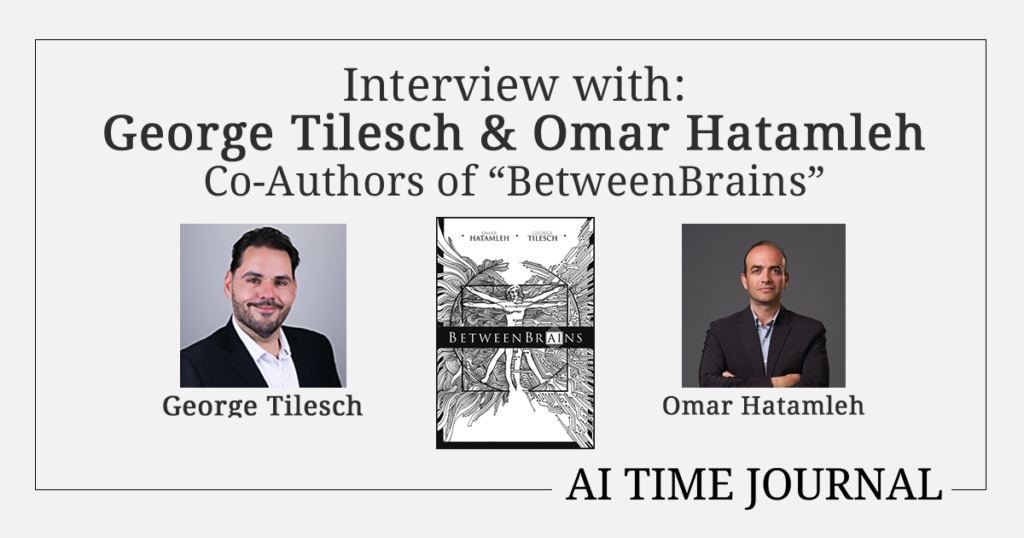
Interview with George Tilesch and Omar Hatamleh, Co-Authors of “BetweenBrains”
We thank George Tilesch and Omar Hatamleh for taking part in this interview and sharing their views on a broad range of key challenges and opportunities in AI, as discussed in their recently-published book “BetweenBrains”.
Dr. George Tilesch is the former Chief Strategy and Innovation Officer, Global Affairs at Ipsos, and a senior global innovation and AI expert who is a conduit and trusted advisor between the US and EU ecosystems, specializing in AI Ethics, Impact, Policy, and Governance.
Dr. Omar Hatamleh is the former Chief Innovation Officer, Engineering at NASA, and former Executive Director of the Space Studies Program at International Space University.
Q: George and Omar, at what point did you realize that you wanted to write this book, and what inspired you to work together?
GT: The inspiration came from a series of serendipitous “accidents” and revelations, and continued throughout the 3 years of actually writing BetweenBrains, while also actively working in the AI strategy consulting and research fields. Around 2016, a palpable change started when the first big bets have been visibly placed on AI by industry, venture capital, and some major governments. While everybody was still talking Skynets and HALs in the public dialogue, we understood that this was all happening now without most people noticing – so the now and near future is what we wanted to cover in the book. Initially, what shocked me at the time was the vast differences in the tone of leaders when conveying the grand AI ambitions and boundless AI-optimism of their organizations; and when they were talking in private expressing concern as citizens, consumers, parents…I was sure we were on to something and got intrigued to go backstage, dig deep and understand the lure, the power, and impact, as well as the risks and challenges of AI, in a balanced way. Omar and I see eye to eye not just as friends, but we share the same cross-sector and cross-industry perspective by default, as well as the moral convictions that anchor us firmly when studying such a complex and alluring topic; so ours was a natural-born partnership from day one.
Q: Tell us about how you chose the title of the book, “BetweenBrains”.
GT: Unlikely choice, but our title was originally borrowed from neuroscience: the betweenbrain (diencephalon) is a small, but very important part of the central nervous system. It is a collection of structures that play a number of critical, very diverse roles in our health: most importantly, it is tasked with maintaining homeostasis – system equilibrium in the body. We wanted to hint at our balanced, interdisciplinary approach and bridging mission to give humanity healthy choices in our AI future.
Also, even more importantly, the title refers to the intricate interplay between human and machine intelligence, that, we believe, will define our future to a great extent. We are between human and machine brains – and will be for a very long time. Finally, the “in-between-ness” of our age also equals the timely imperative to make clear choices on what AI objectives we as a society want to achieve, what should be its public-interest purpose, and what choices and actions will take us there. Ultimately, we are firm proponents of Augmented Intelligence as the motto – the less “artificial” it is, the better off human civilization will be.
We wanted to hint at our balanced, interdisciplinary approach and bridging mission to give humanity healthy choices in our AI future.

Q: Who should read “BetweenBrains” and why?
GT: Many AI practitioners, – as well as many leaders across the board, who have to make decisions about AI – , are siloed, somewhat trapped in certain organizational, sometimes very traditional mindsets, and are held back from seeing the full picture to make good decisions. Even leaders feel left out: tech experts complain that they see only lawyers in the room when talking about AI policy, and politicians are suspicious of most inputs coming from tech lobbies. We believe that at this age, given its tremendous impact, as well as its expanding as a field of multi-disciplinary study, AI has to become the subject of mainstream, actionable conversations and an ongoing topic for caring digital citizens that lead to visionary social movements. So on one end of the scale, for AI practitioners, our goal was broadening their horizon with an across-the-board analysis. For well-informed citizens on the other end, we wanted to provide a trusted, unbiased guide to the rules and realities of the AI Age.
We believe that at this age, given its tremendous impact, as well as its expanding as a field of multi-disciplinary study, AI has to become the subject of mainstream, actionable conversations and an ongoing topic for caring digital citizens that lead to visionary social movements.
Q: In the book, you write about AI applied to a number of different industries, including transport, education, and healthcare. Which applications are you most inspired by? In which industry do you see AI having the biggest potential in the coming years?
OH: Many traditional industries will be impacted by AI deployments in their core processes. Artificial intelligence enables computers to perform intelligent tasks that typically require human intelligence like visual perception, decision-making, and speech recognition. Human intelligence has dimensions like empathy, intuition, judgment, passion, emotions, etc., that current artificial intelligence cannot take into consideration. However, cognitive computing systems and AI can be a useful overlay to extend and/or augment the intelligence of humans and their inherent capacities to navigate complexity. In fact, computing systems have become definitively better, at the level of pure rationality, than human beings. Several industries have started adopting AI to improve various roles in their sector like productivity, efficiency, safety etc. This integration will continue to move forward and will become a cornerstone of many industries. AI is transcending and disrupting industries across the board by transforming and challenging conventional methods. AI has also an enormous role to play in the evolution of the educational system and the educational experience of the future. The ability to sift through the complexities of interpreting and processing enormous amounts of unstructured data gives AI an important role in modifying and revolutionizing the educational system. Artificial Intelligence is also expected to have an enormous impact on healthcare in terms of quality, efficiency, and performance. Many healthcare institutions have already started to harvest the value from AI-integrated systems, and more fast adoption is expected to continue at various levels. AI can also extend to creative fields by enabling emerging technologies like 3D printing, holographic photonics, AI and ML applied to image recognition, etc. have the potential to augment artists’ capabilities and output by providing unique creative options as the result of the aggregation and almost real-time analysis of vast sets of data and complex information from various sources.
Q: Tell us about “the dream of autonomous transportation”, as referenced in BetweenBrains. What trends do you see emerging in the autonomous vehicle industry?
OH: One of the main goals for autonomous cars is to achieve zero accidents by taking out the weakest link in the driving process: human error. If successfully implemented and the technology is matured, that alone can result in significant saving of lives and eliminating the large majority of injuries on the road. Autonomous transportation will also result in an increase in productivity due to reduced accidents, ability to work while on the road, and could be an important catalyst for economic growth.
Autonomous cars will have big impacts on traffic and the environment. Autonomous cars will significantly contribute to the reduction in the number of cars on the road. Families will no longer need two, three, or four cars. One single vehicle will do that job. In addition, interactions and communications among autonomous cars will enable cars to be at a closer distance while driving at high speeds, thus reducing or eliminating traffic congestion. The reduction in the number of cars will create an environment with significantly less traffic, which translates to less pollution and more environmentally friendly towns across the world.
Aging demographics won’t have to be concerned about having their driver’s licenses revoked due to old age. All their transportation needs can be fulfilled through this technology. There are numerous benefits from embracing a near future where autonomous cars will be part of everyday life, but do all these advantages come without a cost?
Driving on a daily basis entails the use of several cognitive skills as we navigate through various driving scenarios. The older we get, the more we tend to exhibit a decline in those cognitive abilities. Some recent studies have indicated that driving may actually help reduce age-related cognitive decline. We also will need to research long-term cognitive decline from lack of driving as more driverless cars make their way to the streets.
As passengers are expected to spend extended periods of time in these vehicles, new technologies that provide services like a mobile office, advanced entertainment systems, food service systems, etc. will emerge creating new economies and business models. The potential adverse implications on insurance companies, car manufacturers, commercial parking spaces, and the energy sector will need to be considered by these different industries. Executives from these industries will need to adapt and transform their existing value proposition to remain relevant in this wave of emerging technology.
Q: What is the current status of the global race towards AI dominance, and what do you foresee for the coming years?
GT: We should be very mindful of what is going on behind the scenes, but not accept the race mentality as the only way forward. What happened in the last few years was that some powers betting big on AI – including on the weaponization of AI – set a scene that may dictate the logic, development directions and pace for others who will be forced into the race even against their will. With more sophisticated methods of course, the race is also on in the commercial realm as the big players are very much aware how even 1% of a lead in a given AI subdomain converts to exponential rewards in positions of dominance, leapfrogging and revenue. The geostrategic ley lines are being redrawn with AI and the boundaries between sectors are getting blurrier as the current race intensifies – but is less than beneficial for humanity’s interest. In the short term, specialization pays off, as well as the concentration of power that is implicit in AI may well favor the unscrupulous. What we are trying to demonstrate in the book is how this race mindset should be superseded by one that seeks the true purpose of AI and makes that vision inclusive and actionable for our civilization. We are trying our best to support those who feel left out or outpaced, all that with a deep belief that a sustainable, inclusive, value-creating and beneficial AI paradigm – that is also a real, competitive alternative – is the only true panacea against the all-encompassing race. It has to sink in that we all are the shapers of whose image AI takes: fulfilling that vision needs all responsible stakeholders.
What we are trying to demonstrate in the book is how this race mindset should be superseded by one that seeks the true purpose of AI and makes that vision inclusive and actionable for our civilization.
Q: In “BetweenBrains”, several AI-related ethical challenges are discussed. Which ones do you think deserve the most attention and why?
GT: Unlike how it looked when we started with the book, AI ethical challenges are highly mediatized now. Nevertheless, in these polarized times, citizens are confined to positions to formulate a “yay” or “nay” opinion on the vast complexity of AI without having adequate, unbiased information – and this is utterly wrong in our eyes. AI Ethics is a burgeoning domain that needs to permeate the public mind much deeper, to guide the hands of AI constructors and policymakers alike. By and large there is a consensus emerging regarding ethical principles such as ensuring human agency, safety, privacy, transparency, accountability, fairness and well-being, etc. However, “ethics to policy” and “ethics to consumer/citizen expectations” are the frontlines now that need to be tackled.
Beyond what is currently labeled as AI Ethics, where we see more actionability are the domains that approach AI from the risk and impact perspectives. How does AI perpetuate human bias, and is it better than good old human bias? How do we consciously target Explainable AI development that overcomes the Black Box conundrum and is the antechamber for meaningful regulation in establishing accountability behind AI applications? How do users of AI tools resist the lure of trusting AI decisions and pushing away responsibility for decisions, aka. “AI made me do it”? How do consumers get ready mentally for AI, history’s best salesperson – and much of the same with citizens resisting political manipulation? What is the best path to teach AI morality, since it is already making moral decisions without getting any of the context?
Q: Chapter 6 of “BetweenBrains” is dedicated to the topic of “AI and Democracy”: what are the challenges and opportunities that AI brings to democratic societies around the world?
One of our main arguments in the book is that in these early AI days, we should ask the hard and deep questions that are not being asked and discussed widely. In our Narrow AI age, it is a game of the few, affecting the lives of many. As AI develops in leaps and bounds from narrow to general-purpose tech and then towards general intelligence, we are concerned that the equation will not change automatically to favor humanity’s best interests: that requires a lot of hard work, new norms, frameworks, and alliances, that do not exist now. Stakeholders have pieces of the puzzle but we lack the right level of understanding and the overarching vision that would set the course of AI in democratic societies. Primarily we should be very vocal and defined on what purpose this most powerful technology ever created should serve and translate these answers into community, business and policy priorities.
Bottom line, AI (in the shape of Augmented, not Artificial Intelligence) can potentially become the most powerful tool for democracies – but through a vast set of nefarious AI-powered technologies available now, also the ruin of them. Through the optimistic lens, when in good hands, it can create the tightest, real-time connection ever between citizen needs and policy, model and forecast the best policy choices for citizen well-being, supercharge the efficiency of government services, free up time for much more meaningful work, as well as revolutionize other public benefit domains such as education, healthcare, transport and sustainable urban life.
On the other hand, inequality will most certainly rise in AI’s footsteps without intervention: there are some hard numbers already demonstrating that AI changes the productivity equation fundamentally that calls for a speedy reassessment of economic models. In our grim times, we already witness the onslaught of AI-powered disinformation, AI impersonation technologies, state-backed cyber-manipulation operations et al. Privacy will be under continuous siege: there is a danger that efficiency of AI “national operating systems” that are being piloted now, together with the devastation brought by Covid, can lure some countries onto a path that is a rabbithole of total surveillance, with privacy vaporized. These are probably the gravest of dangers to democratic societies, that citizens and leaders have to realize and make tough choices about, without losing a minute. The next few years will show an accelerated impact of AI on the world of work that needs proactive, deep societal dialogue and novel policy answers including mass retrainings that should also start now. And when talking about novelty, AI evolution necessitates also the creation of parallel steering structures in the domains of societal foresight and anticipatory policymaking. These are unprecedented but critical moves we have to make; we are demonstrating a framework that can serve as a blueprint in the last Manifesto chapter of the book.
Q: George and Omar, what are your next steps now that “BetweenBrains” has been published?
GT: It is now an ebook and print that you can obtain starting out from our site https://betweenbrains.ai/. Soon, we will do multiple language editions to reach global readers. We will do our best to take our conviction beyond being “just a book”. For example, Omar initiated a novel framework and brought together 70 senior innovation executives from all sectors to spend a very intense month together and kickstart a new era in our global Covid resilience innovation capabilities – that obviously has a lot of AI relevance as well, and is now becoming a platform and a movement.
So, as you can see, what intrigues us most now is how to walk the talk. I want to take our AI steering framework, established in the Manifesto chapter, from plan to action in the near future. The aim is to build the viable, scalable model and the cradle for steering Augmented Intelligence. In the same spirit, we would like to take the message and helpful insight to world leaders seeking answers and strategies.
Also, while mostly a secret at this point, the second AI book in the BetweenBrains series is also in the planning in a format unique to the 21st century. The aim is that of a deep dive into the hairiest and most obscure AI topics being made clear and relevant to caring citizens worldwide.
